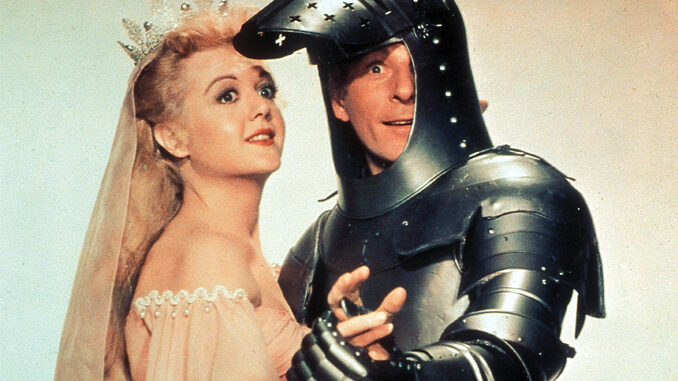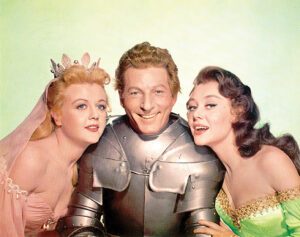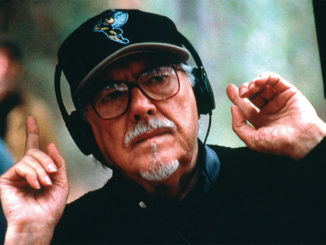
by Gary Marmorstein
When I was growing up in the 1960s, the entertainer Danny Kaye seemed to be everywhere — today traveling the world on behalf of UNICEF, tonight hosting his own CBS variety show. My classmates and I knew the songs from Hans Christian Andersen (1952), even if we boys didn’t always admit it. At summer camp, if I heard a bunkmate wail, “Mommy, gimme a drinka water,” I knew that we owned the same Danny Kaye record.
In fact, Kaye had been a star since my parents’ childhood. Born Daniel David Kaminsky in Brooklyn in 1913, he’d gone from musical revues in New York and London, where he dazzled audiences with rapid-patter songs written for him by his wife Sylvia Fine, to Broadway musicals. He then went to Hollywood, where he specialized in playing lovable dreamers — schlemiels with rich fantasy lives.
During my adolescence, I began to wince at Kaye’s patented awestruck expressions and foreign accents. Of one of his movie appearances, Pauline Kael wrote, “If he uses that Irish impersonation again, even the infants may crawl out for a cigarette.” At camp, my bunkmates were now singing Allan Sherman’s and Tom Lehrer’s timelier parodies. For the next three decades, I forgot about Kaye.
I didn’t discover his masterwork, The Court Jester (1955), until my daughter, Rebecca, born 30 years after the film was released, was old enough to watch with me. She was no more than three, but already aware of Danny Kaye because her maternal grandmother had a mint 10-inch vinyl copy of Danny at the Palace (1957). After a rental VHS copy of The Court Jester first appeared in our house, Rebecca was engrossed — so much so that we subsequently bought a copy. And then another.
Written and directed by the veteran comedy team of Norman Panama and Melvin Frank, The Court Jester was shot in VistaVision, Paramount’s widescreen attempt to lure television viewers back into movie theatres. Kaye plays Hubert Hawkins, a carnival entertainer in 12th-century England who longs to be in the thick of it, “steel to steel,” against the usurper King Roderick. But the Black Fox, Roderick’s most feared nemesis, knows Hawkins is better suited to gentler arts, so he assigns him to smuggle the rightful king, an infant, into the palace. Hawkins does so by impersonating a jester known as the Great Giacomo, who discreetly moonlights as an assassin.

The story is as complicated as any by Sir Walter Scott, but I’m not sure Rebecca cared about that. Instead, we were both mesmerized by the opening sequence in which Kaye, in jester costume, appears to be throwing the credits across the screen. She was tickled by the early scene in which Hawkins dances with a troupe of little people. At the behest of the Black Fox, Hawkins exposes the royal birthmark, the purple pimpernel, on the infant king’s rump (Rebecca roared; most young children are attuned to butt jokes) and later sings the king a lullaby. Kaye might as well have been singing directly to my daughter. Meanwhile, I would try to figure out how Panama and Frank had advanced the plot. During those Court Jester screenings, I was also learning how to be a father.
The movie’s musical centerpiece is “The Maladjusted Jester,” which Hawkins performs for King Roderick. If I was responding to the pseudo-Freudian lyric about what it means to be an entertainer, Rebecca was responding to Kaye’s irrepressible clowning; he was, once again, playing the palace. As the movie resolves its comic intrigues, there’s fine work from Cecil Parker as Roderick, Basil Rathbone as the sneering Lord Ravenhurst, crackly-voiced Glynis Johns and Angela Lansbury as the haughty princess who falls in love with Hawkins. The newly knighted Hawkins is forced to duel for the princess’ hand, which yields one of the greatest comedy sequences in movie history — Hawkins’s attempt to master the life- or-death tongue-twister: “The pellet with the poison’s in the vessel with the pestle; the chalice of the palace has the brew that is true!”
Rebecca, absorbing language at supersonic speed, could repeat Kaye’s readings of those lines without necessarily understanding them. As the movie wraps up its various plot lines and the rightful king is restored to the throne, you realize that The Court Jester has practically decapitated the Age of Chivalry with mace and chain, but has done so with affection.
When my son Darius was old enough to watch the film (then on DVD), I went through a second flurry of viewings, and marveled again at the achievements. Over the years, evaluating film projects for 20th Century Fox, I have probably compared too many of them to The Court Jester and found them wanting. But I almost can’t help it; this beautiful comedy still has the brew that is true.





